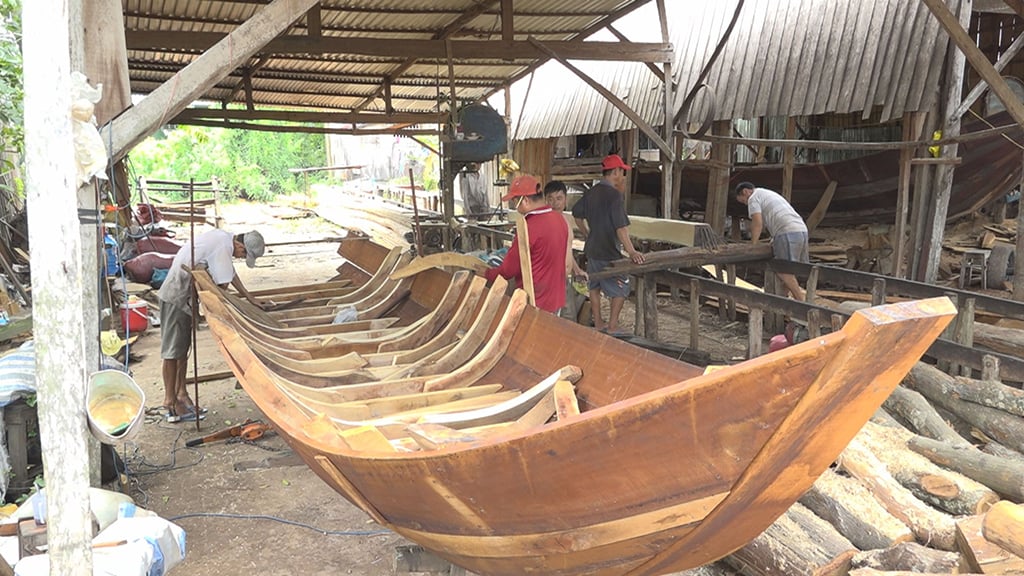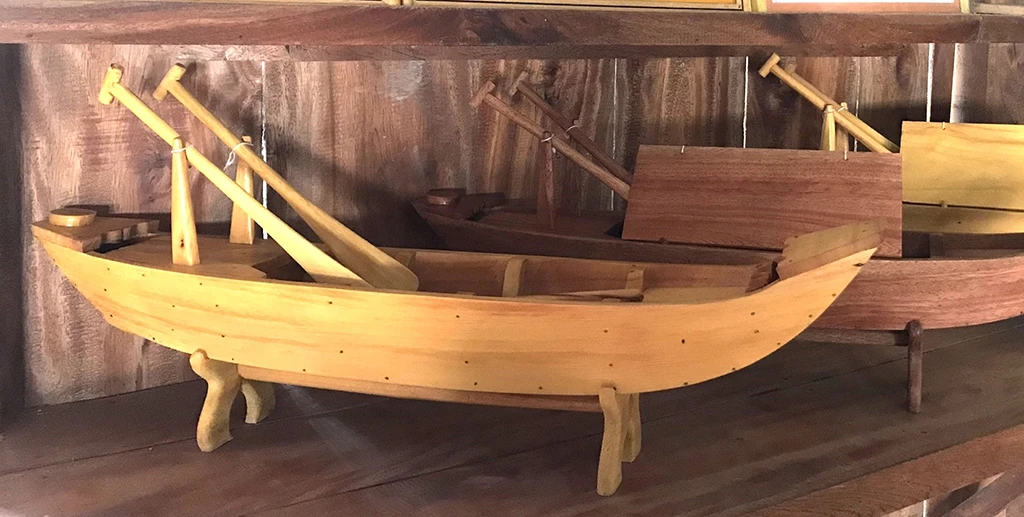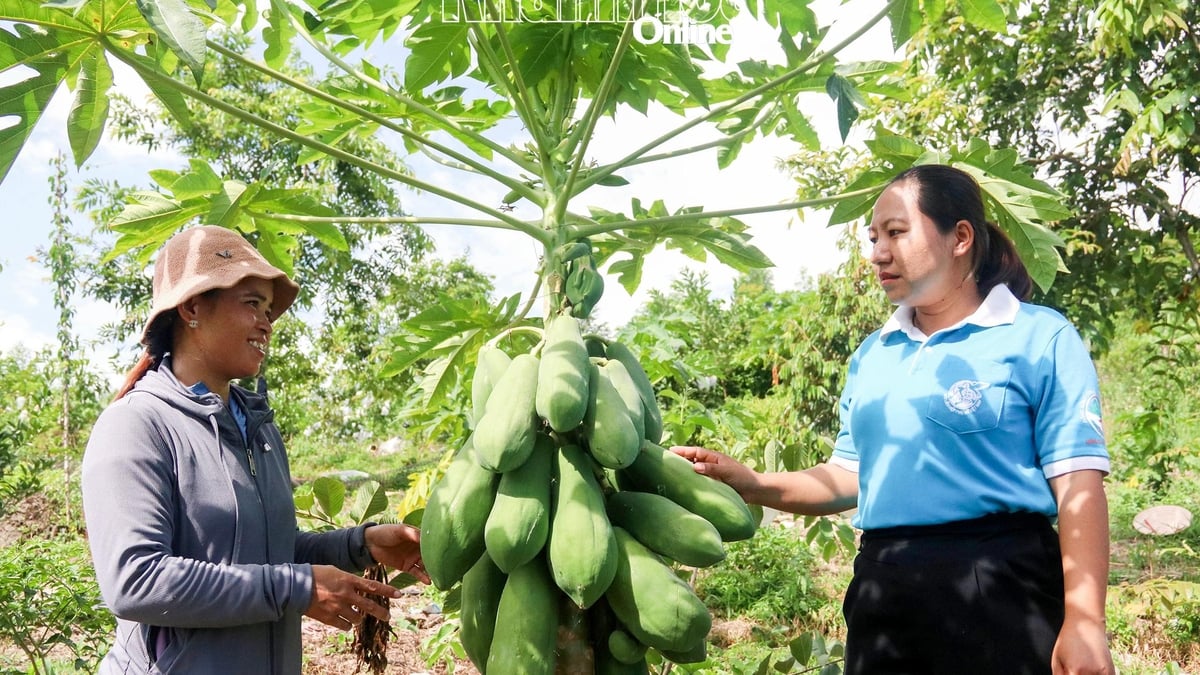Lighting the boat
Talking to Thanh Nien reporter, Mr. Nguyen Van Tot (commonly known as Bay Tot, 63 years old, living in Long Hau commune, Lai Vung district, Dong Thap ) said that his family has been making boats for 4 generations. Around 1970 - 1972, this profession was very prosperous. Working during the day was not enough, so at night every family burned kerosene lamps to make boats, but still not enough to deliver to customers. Children of 14 - 15 years old already knew how to help their parents make boats.

The boat building profession in Ba Dai canal has been formed and developed for more than 100 years.
According to Mr. Bay Tot, about 20 years ago, along Ba Dai canal, there were more than 200 households making boats and sampans. Thanks to the tradition of passing down the craft from father to son and hand-holding to pass on all the secrets, the craft village always had a generation of skilled craftsmen to inherit, building durable and beautiful boats and sampans.
During its heyday, Long Hau commune sold tens of thousands of boats and sampans each year. The products of sampans, sampans, fishing boats, and tac rang bearing the Ba Dai brand were not only sold throughout the Mekong Delta region but also to Cambodia. The reputation of the craft village has spread to this day.
According to the elders, the beginning of April to the end of August of the lunar calendar is the busy season for making boats. Every year when the flood waters rise, people's demand increases and the business season of the boat factories lasts until the 10th lunar month. Normally, people abstain from building boats at night; but when there is a high demand, the workers build until late at night before resting. Because this is the time when "a day's work brings a month's food" for the boat factories, the surrounding people are sympathetic.
To have a finished boat, it must go through many stages, such as: cutting the frame, bending the frame, pinning the frame, assigning work, assembling the sides, building the deck, carving the bow, etc. Skilled workers can build 2 small boats per day, while large boats with a capacity of 40 - 50 tons take 40 days to complete. Male workers select wood, saw, ink, bend the frame, saw, cut, plan...; women take care of cooking, caulking bottles, filling jars; children pull out nails, collect shavings, sawdust, firewood, etc. Each finished product is the contribution of many people.
Product improvement to develop craft villages
According to many documents, Mr. Pham Van Thuong (Sau Thuong, 1875 - 1945, local resident) is considered the founder of the craft of building boats and sampans in Ba Dai canal. He was very good at carpentry, making cabinets, tables and chairs, building houses and building beautiful boats and sampans. In particular, the sampan model for fishing and netting in the fields that he built was so beautiful that many people called him "Mr. Sau sampan".

Mini boats and canoes built by Mr. Nguyen Van Tot have become tourism products.
Seeing that Mr. Sau Thuong was good at his craft, Mrs. Le Thi Nham (from Rach Ba Dai) invited him to her house to teach her eldest son, Hai Hy. During the teaching process, feeling sorry for Mrs. Nham, a widow, raising four children alone, Mr. Sau Thuong developed feelings for her and the two became husband and wife, and later they had a daughter together. Hearing of Mr. Sau Thuong's reputation, many families sent their children to learn the craft. Since then, many classes of excellent students trained by him have researched and innovated to build many types of boats, durable and skillful such as: Cai Rang gourd boat, Can Tho gourd boat, An Giang ca dom boat, Long An three-leaf boat...
Every year, on the 25th day of the 7th lunar month, boatmen in Ba Dai gather to commemorate the death of their ancestor - Mr. Sau the boatman.
Thus, many generations of workers passed on their skills to each other, and when they were proficient, they set up their own camps. Gradually, equipment serving the profession such as wood saws, saws, planers, and parasol machines replaced human labor, contributing to increased competitiveness and better quality of boats and canoes.
As the flood water in the West gets lower each year, road traffic develops, composite plastic boats become popular... the number of households making boats in Ba Dai canal has gradually decreased over time. From 200 households in the prosperous period, by 2018 there were only 50 households left and now there are very few households making boats.
Unable to stand by and watch the traditional craft villages of his hometown gradually fade away and become forgotten, around 2012, Mr. Nguyen Van Tot researched and built a compact mini-canoe, the prototype of which was the same as the large canoe, to preserve and promote to tourists. The mini-canoe was well received by the market, especially by eateries, restaurants, and tourist attractions, which ordered it for nearly 1 million to tens of millions of VND each.
Up to now, the number of boats and mini boats built by Mr. Tot has reached thousands, with many models such as: Ba Dai boats, sampan boats, three-leaf boats, Can Tho boats, Soc Trang ngo boats... His products have become tourist gifts for domestic and foreign visitors to Dong Thap, opening up new prospects for the traditional boat and boat building profession in Ba Dai canal.
According to the leader of Lai Vung District People's Committee, in 2005, Dong Thap Provincial People's Committee issued a decision to recognize Ba Dai boat building craft, Long Hau commune as one of the important traditional craft villages in the planning of developing traditional craft villages of the province, in order to have support in terms of facilities, science and technology, and support for investment capital to promote the development of the craft village. By April 2015, the craft village was recognized by the Ministry of Culture, Sports and Tourism as a national intangible cultural heritage, an opportunity for people to preserve and develop the craft village.
Source link




















































![[Maritime News] More than 80% of global container shipping capacity is in the hands of MSC and major shipping alliances](https://vphoto.vietnam.vn/thumb/402x226/vietnam/resource/IMAGE/2025/7/16/6b4d586c984b4cbf8c5680352b9eaeb0)













































Comment (0)